skiing: Elite Feet perfecting boots
- the sloppy Italians used a velcro™ knockoff for the power strap at the topthat simply doesn't velk — the straps break loose while skiing and slide apart when I carry the boots
- water gets into the shell and after a few hours of skiing I can feel dampness in the liner
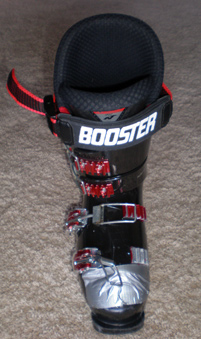 I know Cosmo's Footwerks makes beefy power straps but I wanted to stay with Elite Feet who have adjusted and repaired the boots a few times over the years, always for free. I went in mid-week while Christian was around (Elite Feet is busy with a second shop at Northstar) and he replaced Nordica's joke straps with BOOSTER straps. These have a huge vibration-damping pad in front and a solid metal cam closure that locks in tight.
I know Cosmo's Footwerks makes beefy power straps but I wanted to stay with Elite Feet who have adjusted and repaired the boots a few times over the years, always for free. I went in mid-week while Christian was around (Elite Feet is busy with a second shop at Northstar) and he replaced Nordica's joke straps with BOOSTER straps. These have a huge vibration-damping pad in front and a solid metal cam closure that locks in tight.As for the water intrusion, I used the awesome power of duct tape and it's made some improvement. Nordica inexplicably cut a notch into the shell near the first buckle.
Meanwhile a Shred Betty had some problems angulating and engaging her inside ski's outside edge in her Nordica boots. Legendary instructor Tim Reeve recommended Start Haus to her boots and possible canting. But instead of working with the boots she brought, the boot fitter said they were too loose and tried to put her in Dobermans. Rule 1: if someone tries to put you in a tighter boot, they're showing off their boot-fitting prowess above listening to your needs. Instead, Christian at Elite Feet suggested removing her liners, allowing them to swell up and reverse some of the "packing out" that compresses the liner over the years. He tested her for canting using Elite Feet's complex mechanical rig (much better than a plumb bob from the knee, and shaved her boots down, inserting the special red shims in the photo and planing the boots so they engage with bindings.
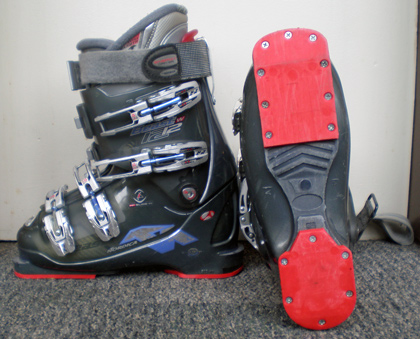
I was hoping a gross misalignment would explain my blown turns to the right with my left ski railing instead of engaging a turn, but no such luck; Christian tested me on the rig and I'm true.
 The only ski movie I own is
The only ski movie I own is 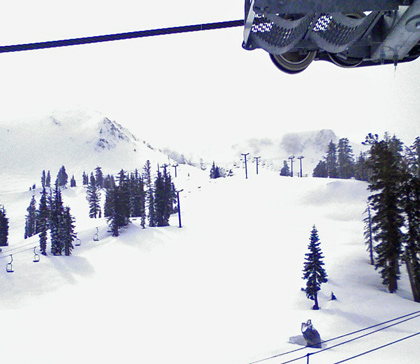
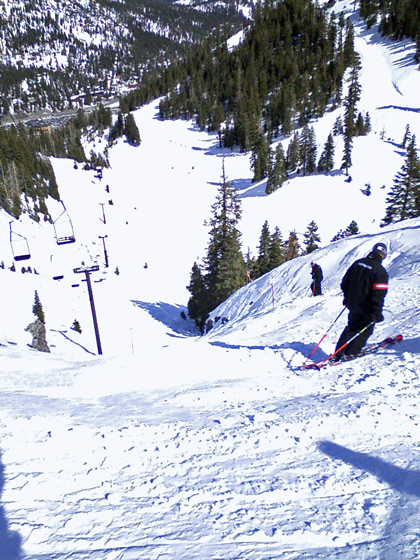
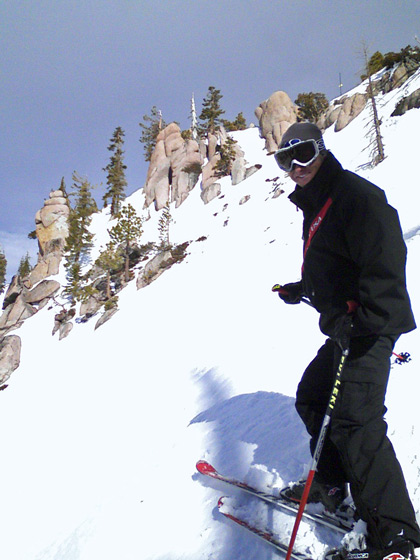
 The
The 

 In mid-December I skied slightly off to the side of KT22 and hit a rock that not only gouged my base but ripped three inches of the metal edge off. It would cost at least $100 to fix, not worth it for such
In mid-December I skied slightly off to the side of KT22 and hit a rock that not only gouged my base but ripped three inches of the metal edge off. It would cost at least $100 to fix, not worth it for such  All three are fine at short-radius turns, though they reward different techniques. You tilt the Metron 9 on edge and the fat tip just digs in and starts turning, the rest of the ski bends into a curve, and if you don't screw up, sharp turns happen; you feel like you're standing at the center of springy rubber bands. You scoop the Allstar tip into a turn and then ride the entire edge through the turn. You guide the solid front of the AC3 into a turn with a combination of tipping and steering, and modulate both throughout the turn. The reviews got it partly right, the AC3 is a fine crusing ski, but you can take it out of that comfort zone and have fun with it. And that ease let me ride it long, in 177 cm instead of 167-172 with some other skis. (I remember when 204 cm was considered short.) I bought the AC3!
All three are fine at short-radius turns, though they reward different techniques. You tilt the Metron 9 on edge and the fat tip just digs in and starts turning, the rest of the ski bends into a curve, and if you don't screw up, sharp turns happen; you feel like you're standing at the center of springy rubber bands. You scoop the Allstar tip into a turn and then ride the entire edge through the turn. You guide the solid front of the AC3 into a turn with a combination of tipping and steering, and modulate both throughout the turn. The reviews got it partly right, the AC3 is a fine crusing ski, but you can take it out of that comfort zone and have fun with it. And that ease let me ride it long, in 177 cm instead of 167-172 with some other skis. (I remember when 204 cm was considered short.) I bought the AC3! Here are my skis: fat-ish 188cm Volkl G41's from about 2000 and the legendary mid-fat Salomon XScream Séries in one of their weird power ratings from 1998. As you can see I continue to shred the living daylights out of my right ski, which means both need replacing. The XScream seems to take the abuse well, but the Volkl wood core is exposed to moisture and that's not good.
Here are my skis: fat-ish 188cm Volkl G41's from about 2000 and the legendary mid-fat Salomon XScream Séries in one of their weird power ratings from 1998. As you can see I continue to shred the living daylights out of my right ski, which means both need replacing. The XScream seems to take the abuse well, but the Volkl wood core is exposed to moisture and that's not good.
